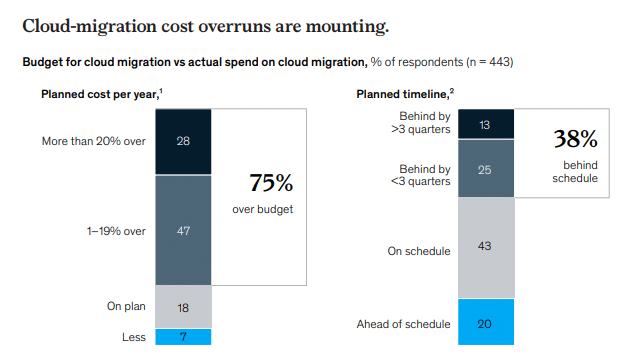Skip the Replatform: Future-Proof Commerce with Smart Integration

While e-commerce replatforming offers modernization, it carries significant risks, including high costs, business disruption, complex data migration, and steep learning curves, often exceeding planned budgets.
An intelligent alternative involves adopting an integration-first strategy with solutions like fabric’s AI-powered OMS, allowing businesses to add advanced capabilities (e.g., smart inventory, optimized fulfillment, AI insights) into existing Shopify setups without a costly and disruptive full system overhaul.
Replatforming your e-commerce site is a significant undertaking that requires careful planning and execution. If you’re operating on an on-premises infrastructure, transitioning to a cloud environment demands a detailed cloud migration strategy to avoid pitfalls.
From migrating customer data and third-party integrations to retraining your development team, every part of the replatforming process demands significant time, coordination, and financial resources.
According to research by McKinsey, businesses often underestimate this reality; cloud migration projects have exceeded planned costs by an average of 14%, leading to over $100 billion in wasted spending globally within three years due to mismanaged transitions.

Source: McKinsey
While e-commerce replatforming is often viewed as the gateway to digital transformation, it comes with significant trade-offs, particularly in terms of business continuity, customer satisfaction, and overall cost control.
But what if there were a way to achieve next-generation commerce capabilities without the upheaval of a full replatform?
Rather than replacing core systems with a complex overhaul, explore integration-first strategies that can bring cloud-native features and AI-powered enhancements into your existing infrastructure.
In this article, we’ll explore how AI revolutionized order management, how composable, API-first integrations can help your business modernize without compromising performance, and how intelligent solutions like fabric’s AI-powered OMS can support the digital transformation of your business while preserving the stability of your current system.
The allure (and the pitfalls) of replatforming
Replatforming an e-commerce site often stems from the need to modernize outdated systems, enhance scalability, and improve user experience. However, this process presents its own challenges.
Many teams first ask, “How does replatforming impact our workflows and systems?”, a critical question that often leads to underestimated complexities.
Businesses typically consider replatforming to address several issues:
- Outdated systems: Legacy platforms may lack the flexibility to support new features or integrations.
- Scalability issues: As your business grows, your platform must handle increased traffic and transactions.
- Poor integrations: Inadequate integration capabilities can hinder operations and customer experience.
- Desire for better UX: Modern consumers expect seamless and intuitive online shopping experiences.
Significant costs involved
Replatforming requires substantial investment in terms of finances, time, and resources. Yet, many businesses still opt for it, hopeful about the long-term benefits of replatforming, such as increased performance and future scalability.
According to a report by Digital Commerce 360, approximately 27% of businesses plan to spend between $25,000 and $500,000 on replatforming efforts.
Potential for business disruption
The migration journey often comes with operational downtime that can affect your online store, disrupt workflows, and impact customer satisfaction. Even a brief interruption in service can erode buyer trust and delay revenue generation, especially if your commerce platform is tied into multiple channels.
Complexity of data migration
Transferring customer data, product catalog, and integrations from an existing e-commerce platform to a new cloud platform or cloud infrastructure is a complex task, especially when consolidating multiple data storage sources to ensure seamless continuity.
Without careful handling, the migration process can lead to data inconsistencies, broken connections, or missing fields—all of which can damage core functionality.
Learning curve for new systems
New systems often require your development team and operations staff to unlearn old workflows and adjust to the platform features, underlying architecture, and user experience of modern platforms.
This can cause temporary inefficiencies, delays, and knowledge gaps, particularly when switching from legacy applications to cloud-based platforms with unfamiliar cloud native features. Understanding the cloud features offered by your target system is essential to minimize friction.
The intelligent alternative: Integrated AI solutions
Replatforming isn’t the only path to modernizing your commerce operations. An alternative approach involves strategically integrating new capabilities into your existing systems, minimizing disruption while maximizing agility.
Modern commerce architecture encompasses concepts such as composable commerce and API-based connectivity. This approach is often more cost-effective than traditional lift-and-shift migration methods, as it reduces the need for massive code rewrites or adopting entirely to a new infrastructure.
This modular approach allows you to select and integrate best-of-breed solutions tailored to your specific needs, enhancing flexibility and reducing time-to-value. By leveraging APIs, you can seamlessly connect various services, enabling rapid adaptation to market changes and customer demands.
Implementing this strategy offers several benefits:
- Flexibility: Easily add or replace components without overhauling the entire system.
- Faster time-to-value: Deploy new features and services more quickly, responding promptly to market opportunities.
- Reduced risk: Minimize the potential for disruptions by avoiding large-scale system replacements.
fabric is a set of AI-powered tools with an API-first design that can enable you to enhance your commerce capabilities while preserving your existing infrastructure. By focusing on agility and a customer-centric approach, fabric can help you future-proof your operations and deliver superior shopping experiences.
Enhancing your existing commerce tech
Instead of undertaking a complete overhaul of your legacy systems, integrating intelligent solutions into your existing platform can address many limitations that often drive replatforming. This approach leverages your current infrastructure while introducing advanced capabilities to meet evolving business needs.
Smarter inventory management
Achieving real-time, unified inventory visibility through integration helps prevent overselling and stockouts. By synchronizing inventory data across all channels, you can maintain accurate stock levels, leading to improved customer satisfaction and reduced maintenance costs.
Optimized order fulfillment
Intelligent order routing enhances efficiency by directing orders to the most suitable fulfillment center, which is especially crucial in distributed data center operations where latency and logistics matter. This optimization reduces shipping times and costs, ensuring timely deliveries and better resource utilization.
Flexible fulfillment options
Integrating solutions enables modern fulfillment methods such as BOPIS (Buy Online, Pickup In-Store) and ship-from-store without necessitating a platform charge. These options provide customers with greater convenience and flexibility, thereby enhancing the overall shopping experience.
Seamless channel expansion
API-based integrations allow for the addition of new sales channels while ensuring compatibility with payment gateways, content management systems, and other core services tied to your cloud capabilities.
This flexibility supports business growth and adaptation to market trends, facilitating a broader reach and increased sales opportunities. You’d no longer be constrained by just one platform—instead, you can orchestrate functionality across multiple systems through APIs.
Continuous improvement through AI
Leveraging AI within your existing systems enables the ongoing optimization of operations, strengthens data security, and boosts the resilience of your cloud transformation efforts.
AI-driven analytics can identify patterns and insights, informing decisions that enhance efficiency, reduce technical debt, and align with long-term business goals. Many AI-driven tools also include built-in security features to help safeguard sensitive commerce operations.
By integrating an AI-powered Order Management System, such as fabric, you can achieve these enhancements without the disruptions associated with full replatforming. This strategic approach supports digital transformation while preserving the stability of your current systems.
Key considerations for an integration-first strategy
Adopting an integration-first approach allows you to enhance your existing systems without the need for a complete overhaul. To ensure a successful implementation, consider the following factors:
Assess current system capabilities
Begin by evaluating your current system to identify strengths and limitations. Understanding the capabilities of your existing infrastructure helps determine which areas would benefit most from integration.
Identify key pain points and desired outcomes
Pinpoint specific challenges within your operations, such as inefficiencies in order processing or inventory management. Clearly defining these pain points and the outcomes you wish to achieve will enable the integration process to be conducted effectively.
Evaluate integration options
Research and select integration solutions that align with your business goals and technical requirements. Consider factors such as compatibility with your existing system, support for managed services, and the ability to scale across multiple scalable systems.
Prioritize API accessibility
Ensure that the solutions you choose offer robust and accessible APIs. API-based connectivity is essential for seamless communication between various components of your digital infrastructure, enabling flexibility and supporting future growth.
Data flow and compatibility planning
Develop a comprehensive plan for data migration and integration. Address potential compatibility issues between new solutions and your existing code to maintain data integrity and system performance.
Evolve your commerce without the overhaul
If you’re considering replatforming your e-commerce business, it indicates that you’re embracing advanced innovation, but it also involves significant risks (which can be mitigated). The truth is, you don’t need a complete overhaul to modernize your commerce platform.
Through intelligent integration, you can enhance core systems, introduce cloud native features, and meet evolving business needs without disrupting operations or overextending resources.
By choosing an integration-first path, you gain the agility to deploy new capabilities incrementally, eliminating the typical replatforming cost and avoiding the risks of replatforming, reducing exposure to downtime or data loss, and accelerating time-to-value. This strategy enables you to address challenges related to data migration, scalability, and customer satisfaction—all while maintaining the stability of your existing infrastructure.
As the e-commerce landscape evolves, the ability to scale with precision becomes a competitive edge. Whether you’re sticking to your existing platform or planning to switch to a new platform, adopting an integration-first strategy gives you the best of both worlds.
Solutions like fabric’s AI-powered cloud-based platform can layer into your current platform to deliver real-time insights, enhanced security, and a smoother migration strategy, without rewriting your entire stack.
Instead of leaning towards traditional replatforming, take a strategic step forward. Explore how smart, composable integration can unlock new growth opportunities and help future-proof your digital commerce strategy with the right cloud provider and thoughtful replatforming strategy.

Digital content editorial team @ fabric




